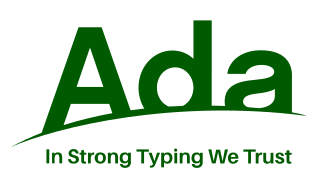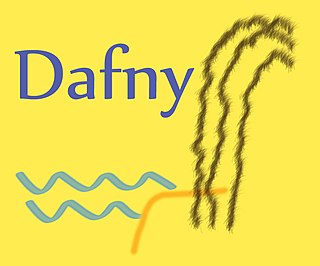Related Research Articles

Ada is a structured, statically typed, imperative, and object-oriented high-level programming language, inspired by Pascal and other languages. It has built-in language support for design by contract (DbC), extremely strong typing, explicit concurrency, tasks, synchronous message passing, protected objects, and non-determinism. Ada improves code safety and maintainability by using the compiler to find errors in favor of runtime errors. Ada is an international technical standard, jointly defined by the International Organization for Standardization (ISO), and the International Electrotechnical Commission (IEC). As of May 2023, the standard, called Ada 2022 informally, is ISO/IEC 8652:2023.

A programming language is a system of notation for writing computer programs.
In computer science, pseudocode is a description of the steps in an algorithm using a mix of conventions of programming languages with informal, usually self-explanatory, notation of actions and conditions. Although pseudocode shares features with regular programming languages, it is intended for human reading rather than machine control. Pseudocode typically omits details that are essential for machine implementation of the algorithm, meaning that pseudocode can only be verified by hand. The programming language is augmented with natural language description details, where convenient, or with compact mathematical notation. The purpose of using pseudocode is that it is easier for people to understand than conventional programming language code, and that it is an efficient and environment-independent description of the key principles of an algorithm. It is commonly used in textbooks and scientific publications to document algorithms and in planning of software and other algorithms.
Structured programming is a programming paradigm aimed at improving the clarity, quality, and development time of a computer program by making extensive use of the structured control flow constructs of selection (if/then/else) and repetition, block structures, and subroutines.
An optimizing compiler is a compiler designed to generate code that is optimized in aspects such as minimizing program execution time, memory use, storage size, and power consumption. Optimization is generally implemented as a sequence of optimizing transformations, algorithms that transform code to produce semantically equivalent code optimized for some aspect. It is typically CPU and memory intensive. In practice, factors such as available memory and a programmer's willingness to wait for compilation limit the optimizations that a compiler might provide. Research indicates that some optimization problems are NP-complete, or even undecidable.
In computer science, control flow is the order in which individual statements, instructions or function calls of an imperative program are executed or evaluated. The emphasis on explicit control flow distinguishes an imperative programming language from a declarative programming language.
Befunge is a two-dimensional stack-based, reflective, esoteric programming language. It differs from conventional languages in that programs are arranged on a two-dimensional grid. "Arrow" instructions direct the control flow to the left, right, up or down, and loops are constructed by sending the control flow in a cycle. It has been described as "a cross between Forth and Lemmings".
In computing, inline expansion, or inlining, is a manual or compiler optimization that replaces a function call site with the body of the called function. Inline expansion is similar to macro expansion, but occurs during compilation, without changing the source code, while macro expansion occurs prior to compilation, and results in different text that is then processed by the compiler.
In computer programming, specifically when using the imperative programming paradigm, an assertion is a predicate connected to a point in the program, that always should evaluate to true at that point in code execution. Assertions can help a programmer read the code, help a compiler compile it, or help the program detect its own defects.
In the C programming language, Duff's device is a way of manually implementing loop unrolling by interleaving two syntactic constructs of C: the do-while loop and a switch statement. Its discovery is credited to Tom Duff in November 1983, when Duff was working for Lucasfilm and used it to speed up a real-time animation program.
In computer science, program synthesis is the task to construct a program that provably satisfies a given high-level formal specification. In contrast to program verification, the program is to be constructed rather than given; however, both fields make use of formal proof techniques, and both comprise approaches of different degrees of automation. In contrast to automatic programming techniques, specifications in program synthesis are usually non-algorithmic statements in an appropriate logical calculus.
In computer science, a loop invariant is a property of a program loop that is true before each iteration. It is a logical assertion, sometimes checked with a code assertion. Knowing its invariant(s) is essential in understanding the effect of a loop.
High-Level Assembly (HLA) is a language developed by Randall Hyde that allows the use of higher-level language constructs to aid both beginners and advanced assembly developers. It supports advanced data types and object-oriented programming. It uses a syntax loosely based on several high-level programming languages (HLLs), such as Pascal, Ada, Modula-2, and C++, to allow the creation of readable assembly language programs, and to allow HLL programmers to learn HLA as fast as possible.
In computer programming, a statement is a syntactic unit of an imperative programming language that expresses some action to be carried out. A program written in such a language is formed by a sequence of one or more statements. A statement may have internal components.
Predicate transformer semantics were introduced by Edsger Dijkstra in his seminal paper "Guarded commands, nondeterminacy and formal derivation of programs". They define the semantics of an imperative programming paradigm by assigning to each statement in this language a corresponding predicate transformer: a total function between two predicates on the state space of the statement. In this sense, predicate transformer semantics are a kind of denotational semantics. Actually, in guarded commands, Dijkstra uses only one kind of predicate transformer: the well-known weakest preconditions.
The Java Modeling Language (JML) is a specification language for Java programs, using Hoare style pre- and postconditions and invariants, that follows the design by contract paradigm. Specifications are written as Java annotation comments to the source files, which hence can be compiled with any Java compiler.

Goto is a statement found in many computer programming languages. It performs a one-way transfer of control to another line of code; in contrast a function call normally returns control. The jumped-to locations are usually identified using labels, though some languages use line numbers. At the machine code level, a goto is a form of branch or jump statement, in some cases combined with a stack adjustment. Many languages support the goto statement, and many do not.

TLA+ is a formal specification language developed by Leslie Lamport. It is used for designing, modelling, documentation, and verification of programs, especially concurrent systems and distributed systems. TLA+ is considered to be exhaustively-testable pseudocode, and its use likened to drawing blueprints for software systems; TLA is an acronym for Temporal Logic of Actions.
Whiley is an experimental programming language that combines features from the functional and imperative paradigms, and supports formal specification through function preconditions, postconditions and loop invariants. The language uses flow-sensitive typing also known as "flow typing."

Dafny is an imperative and functional compiled language that compiles to other programming languages, such as C#, Java, JavaScript, Go and Python. It supports formal specification through preconditions, postconditions, loop invariants, loop variants, termination specifications and read/write framing specifications. The language combines ideas from the functional and imperative paradigms; it includes support for object-oriented programming. Features include generic classes, dynamic allocation, inductive datatypes and a variation of separation logic known as implicit dynamic frames for reasoning about side effects. Dafny was created by Rustan Leino at Microsoft Research after his previous work on developing ESC/Modula-3, ESC/Java, and Spec#.
References
- ↑ Back, Ralph-Johan: Invariant Based Programming: Basic approach and Teaching Experience, Formal Aspects of Computing, 14 February 2008, ISSN 0934-5043 (Print) 1433-299X (Online)